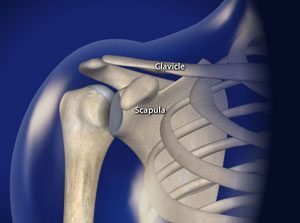 Shoulder dislocation is a condition that many of us have heard of – and suffered from. Not uncommon in many sports due to a fall or collision, a dislocation occurs when the humerus bone (the upper end of the arm bone), pops out of the shoulder joint. Although similar, a shoulder subluxation is a partial separation. But don’t let the word “partial” confuse you, because a shoulder subluxation can still be painful and lead to recurrence and long term effects if not properly diagnosed and treated.
Shoulder dislocation is a condition that many of us have heard of – and suffered from. Not uncommon in many sports due to a fall or collision, a dislocation occurs when the humerus bone (the upper end of the arm bone), pops out of the shoulder joint. Although similar, a shoulder subluxation is a partial separation. But don’t let the word “partial” confuse you, because a shoulder subluxation can still be painful and lead to recurrence and long term effects if not properly diagnosed and treated.
What exactly is a shoulder subluxation?
Again, when the humerus comes partially out of the shoulder socket beyond normal joint mobility, it’s called subluxation. When subluxation occurs, the patient commonly feels a popping as the ball joint pushes out of the socket. Sometimes the popping is audible.
According to the American Academy of Orthopaedic Surgeons, the majority of shoulder subluxations are anterior, in which the shoulder slips forward. Throwing motions may exacerbate pain with an anterior subluxation. Pain leads to weakness, because the patient avoids uncomfortable motions. The shoulder will often feel numb — and numbness and tingling may travel down the arm.
Diagnosis of shoulder subluxation
Your doctor will ask you questions about your medical history, paying particular attention to any previous injuries to your shoulder. He or she will want to know about the circumstances of the injury and the type and severity of any symptoms that you may be experiencing. Your shoulder will be physically examined, including manipulation of the joint to assess instability and weakness.
An MRI scan can be a useful diagnostic tool, although it does not always show subluxation. An experienced orthopedic surgeon should be able to make a correct diagnosis.
Treatment
Initial treatment typically includes applying ice to the affected area to reduce swelling and relieve pain. Over-the-counter pain medication such as acetaminophen or non-steroidal anti-inflammatory drugs may also be recommended by your physician to reduce inflammation and relieve pain.
It’s also important to rest the shoulder for a few days (sometimes in a sling) – but you don’t want to completely immobilize it in order to avoid developing a frozen shoulder. Once the acute phase has passed, it’s also important to do exercises to strengthen the muscles of the rotator cuff.
Repeated subluxations may require surgical intervention to tighten up the ligaments. Your surgeon may use arthroscopic techniques to make a definitive diagnosis and repair any damage.
Prognosis
Many people can make a good recovery using conservative (non-surgical) treatment. If surgery is required, there will be a period of about 2-3 weeks when the shoulder should be supported by a sling or brace, after which a program of strengthening exercises would begin. A full return to normal activities and sports should be achievable within six months.
If you’re experiencing shoulder pain, weakness and/or numbness, we can help at POSMC. To schedule an appointment with one of our shoulder specialists, please contact our scheduling department at 972-250-5700 or request an appointment online. As always, we’re happy to assist you!
